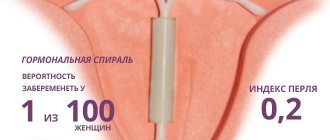Rh conflict during pregnancy is a pathological process that manifests itself in a situation where the mother has a negative Rh factor and the father is positive, and the child acquires the positive Rh factor of the father. If both parents are Rh positive or Rh negative, Rh conflict is not detected.
- Etiology
- Symptoms
- Diagnostics
- Treatment
- Prevention
Rh factor is a special substance that is found in human blood. Doctors have proven that the absence of the Rh factor in a woman’s blood negatively affects the course of pregnancy.
Rh factor (D-antigen) is a protein located on the surface of red blood cells - erythrocytes. It follows from this that a positive Rh factor is inherited by people who have the D antigen on the surface of their red blood cells, and if this substance is absent, the person acquires a negative Rh factor.
A child at an early stage of pregnancy acquires a protein of this kind, and if it turns out to be in a person with a negative blood type, the immune system tries in every possible way to protect the body from the protein entering the blood, since it perceives it as a foreign substance - this is the answer to the question that This is a Rhesus conflict. Unfortunately, this is exactly the situation faced by an Rh-positive mother, in whose body a fetus with a negative Rh factor develops. Rh conflict is observed much more often during the second pregnancy than during the first.
What is the Rh factor?
general information
Rhesus (Rh) is a congenital hematological feature of a person that is inherited. Determined only by the results of laboratory tests. This blood characteristic has no effect on appearance, behavior, or propensity to certain pathologies.
The Rh system is a complex complex of substances of a protein nature that have antigenic qualities, which are contained or absent in various combinations on the cell membrane of erythrocytes.
The name is due to the fact that this group of proteins was originally identified on the surface of red blood cells in the monkey of the same name (macacus rhesus). Since the protein fraction (Rh factor) found on monkey erythrocytes was structurally similar to the human antigen, it was taken as the basis for further research, and the name was fixed in the medical literature.
The erythrocyte system of Rh is saturated with more than fifty antigens that can cause the synthesis of immune antibodies (IgM, IgG). The system does not have natural immunoglobulins. Priority clinical significance for issues of immunology, hematology, transfusiology and obstetrics is given to five protein fractions:
- D (85%);
- C (70%);
- c(80%);
- E(30%);
- e(97.5%).
Frequency values of “popular” antigens are given in parentheses.
Protein (D) is considered to be the most immunogenic; the immunological activity of the others is significantly lower, in descending order: cECe.
Of the proteins that make up the structure of the Rh system, for determining Rh affiliation, only antigen D is of fundamental importance if it is present in the cell membrane of erythrocytes then in humans (Rh+), otherwise negative (Rh-).
The Rh factor itself (a specific protein antigen), whether positive or negative, in life does not correlate in any way with the state of health.
The word factor is “fixed” in the name because this hematological characteristic is considered a factor of blood compatibility during transfusion.
Problems associated with Rh, and extremely serious ones, in addition to the period a woman is waiting for a child, can manifest themselves during the blood transfusion procedure.
Previously, for people who required a transfusion, everything often ended in death, until it was found out that the Rh compatibility factor of the donor and recipient (patient), along with the blood group, plays a priority role in the positive outcome of the procedure.
Severe complications can arise if red blood cells from an Rh+ donor are “transfused” into an Rh- recipient. The body perceives them as a threat due to the presence of D protein (antigen), which the patient’s immunity has not previously encountered.
The response against the “new, foreign” protein fraction is the synthesis of antibodies, which provoke damage and premature destruction (death) of red blood cells.
With the development of the immune reaction, anti-erythrocyte antibodies (immunoglobulins) gradually destroy their own red blood cells, and the massive death of red blood cells causes dysfunction of the liver, spleen (increase in size), and respiratory system.
Rh incompatibility can cause complications during or immediately after the blood transfusion procedure:
- chills;
- temperature increase;
- deterioration of health.
In a negative scenario, including kidney failure, the lack of urgent medical care in such a situation is fatal and can lead to death.
Similar processes (reactions) occur during pregnancy and are caused by incompatibility of the blood of the mother and fetus according to the group or Rh factor.
Antibodies destroy fetal red blood cells, which leads to a number of dangerous, sometimes critical complications:
- hemolytic pathology;
- abortion;
- antenatal (in utero), intranatal (during childbirth) death for a child.
The consequences of Rh-unmatched blood transfusions are severe, often appearing in women after the second transfusion, in men after the third, sometimes even the fourth.
This “slowness” is due to the fact that the recipient’s Rh factor, unlike the blood group, does not manifest itself during the body’s initial acquaintance with donor blood.
Since the Rh system does not have natural immunoglobulins, during the first blood transfusion, the patient’s immunity does not negatively perceive “new”, previously unfamiliar protein fractions. No visible changes occur.
Hemolysins (antibodies) begin to be produced only after the first or subsequent “acquaintance” with the erythrocyte antigens of the Rh (+) donor; the body’s reaction to such encounters can differ significantly.
With repeated blood transfusions, the recipient's antibodies can cause massive agglutination, gluing of red blood cells into a single mass and the start of hemolysis. The resulting blood “lumps” lead to thickening of the biomass in the vessels and provoke the formation of blood clots.
The risks of blood transfusion shock are increasing - an extremely dangerous complication of the transfusion procedure, accompanied by intense hemolysis, with the release of toxic substances into the recipient’s vascular bed.
To avoid the described complications, it is necessary to take into account the Rh compatibility factor of the donor and the patient.
Specific protein D is localized on the surface of the red blood cells of most people; 85-86% of the world's population are Rh positive. In the remaining 14-15%, the blood is genetically “deprived” of this antigen, but this situation is neutral for the body, since the very fact of the presence or absence of Rh does not affect health in any way.
Approximately fifteen percent of expectant mothers (150 out of every 1000) are genetically endowed with Rh-, the frequency of development of Rh incompatibility (the fetus inherited the Rh+ father) is insignificant, accounting for 2% of the total under these conditions. One case per 150-200 births.
Probability tables
Basic hematological characteristics, such as Rhesus or blood group, can be transmitted genetically from the father or mother with an equal degree of probability.
Special tables will help you assess the possible risks of developing a conflict situation.
By blood type
| Group | Probability of conflict | ||
| Father | Mother | Child | % |
| 1 | 1 | 1 | 0 |
| 1 | 2 | 1 or 2 | 0 |
| 1 | 3 | 1 or 3 | 0 |
| 1 | 4 | 2 or 3 | 0 |
| 2 | 1 | 1 or 2 | 50 |
| 2 | 2 | 2 or 1 | 0 |
| 2 | 3 | Any | 25 |
| 2 | 4 | 1,2,4 | 0 |
| 3 | 1 | 1 or 3 | 50 |
| 3 | 2 | Any | 50 |
| 3 | 3 | 1 or 3 | 0 |
| 3 | 4 | 1,2,4 | 0 |
| 4 | 1 | 2 or 3 | 100 |
| 4 | 2 | 1,2,4 | 66 |
| 4 | 3 | 1,3,4 | 66 |
| 4 | 4 | 2,3,4 | 0 |
Rh compatibility chart
| Rh factor | Probability of conflict | ||
| Father | Mother | Fetus | % |
| Plus/Minus | |||
| + | + | 75% 25% | No |
| + | – | 50% 50% | 50 |
| – | + | 50% 50% | No |
| – | – | 0% 100% | No |
Information about compatibility provided in tables, or obtained from calculations of online calculators, which abound on the Internet, is not considered final.
You will receive accurate information only from the results of laboratory tests.
When does it start?
When pregnancy begins, the woman's Rh factor does not change. During the first pregnancy, conflict may not arise. As the fetus develops and forms, antibodies produced by the mother's body enter the child's bloodstream. The first 2-3 weeks, during gestation, the blood of the mother and child mixes. Antibodies are not dangerous for a woman’s body, but they can cause harm to a child’s body.
Important information: Diet for blood type 3 positive (negative) and food table for weight loss for women (men)
According to statistics, Rhesus occurs - incompatibility in the second and subsequent pregnancies. Test results show possible deviations. In rare cases, a mother, father or child may become a carrier of chimerism. From the point of view of genetics, this phenomenon is poorly studied; chimera people have information about two groups simultaneously written in their genetic code.
Etiology
The development of a conflict state is caused by the entry into the bloodstream of the Rh-negative mother of the opposite Rh(+) blood of the fetus, inherited from the father.
Factors predisposing to conflict:
- blood transfusions were carried out without taking into account Rh compatibility (nonsense for modern medical realities, but this reason cannot be completely excluded);
- secondary, or even third expectation of a child;
- previous interruptions - artificial (abortion), spontaneous (miscarriage);
- ectopic pregnancy;
- delivery by caesarean section;
- premature detachment of the “baby place” (placenta);
- bleeding (can occur regardless of the period of embryogenesis);
- Prenatal (antenatal) diagnostic measures - intrauterine puncture of the umbilical cord vessels, biochemical analysis of amniotic fluid (sampling of amniotic fluid), chorionic villi examination.
Current or past pathological conditions can act as catalysts for Rh sensitization of the expectant mother’s body:
- diabetes;
- acute respiratory infections;
- flu;
- dysfunction of organs and systems caused by impaired adaptation of the body to developing pregnancy (preeclampsia).
Pathogenesis
Starting from the 8th week of intrauterine development, the formation of hematopoiesis of the unborn child “starts”. From this date, small amounts of protein D can be laboratory detected in the blood of a mother with a “-” Rh factor.
From the moment the gestational age of the fetus becomes more than two months, risks of Rh conflict arise.
The meeting of red blood cells (RBC) with different rhesus (mother “-“, fetus “+”) is extremely dangerous, leading to agglutination, “sticking together” into single masses.
For the immunity of a Rh-negative mother, positive RBCs of the fetus are perceived by a foreign “agent”, which provokes the body to respond (isoimmunization).
The immune system begins to produce antibodies.
Synthesized anti-Rhesus immunoglobulins (IgM, IgG) “binding” with the D protein prevent agglutination and do not allow red blood cells to unite (stick together).
Conflict during the first gestation
During the first pregnancy, Rh incompatibility rarely leads to complications during pregnancy; in detail, such problems are recorded in isolated episodes.
Antibodies (IgM) produced by maternal immunity are large, “clumsy”, and their concentration is insignificant. This does not allow it to globally overcome the placental barrier, penetrate into the bloodstream of the unborn baby and negatively affect the intrauterine development of the unborn baby.
If the end of the first pregnancy is an abortion, or artificial completion of the birth act is forced, then the likelihood of immunization of the female body increases significantly.
In such cases, the risks of Rh conflict (hereinafter referred to as RK) when expecting a child for the second time, and subsequent times, seriously increase.
Immune memory cells are long-lived; synthesized antibodies after the first birth remain circulating in the bloodstream.
Conflict during the second gestation
If a woman is pregnant for the second time with an Rh-positive fetus, then the body’s immune response is clearer, and the reaction to the secondary appearance of a “foreign” protein is much faster and more global.
The number of synthesized anti-Rh antibodies is larger, smaller in size, and much more mobile than IgM.
Its small size allows it to easily overcome the hematoplacental boundary (barrier), penetrating into the baby’s bloodstream and provoking the destruction of the cell membrane of the Rh-positive red blood cells of the unborn baby. The process of hematopoiesis is inhibited.
Intravascular hemolysis (destruction) of Rh “+” erythrocytes of a child contributes to the accumulation of decay products in the fetal bloodstream, which become more and more abundant as the pathological process intensifies.
Bilirubin is especially dangerous; in excess concentrations it has an extremely negative (poisonous) effect on intrauterine growth and becomes a catalyst for hemolytic disease.
The more intense the hemolysis, the more clearly hypoxia affects the organs. In an attempt to compensate for the lack of destroyed red blood cells, the size of the liver and spleen increases.
In a critical scenario, when the brain is practically deprived of oxygen, dysfunction of the liver and spleen is clearly expressed, and the risks of antenatal death of the baby significantly increase.
Fortunately, given the modern capabilities of medicine, such situations can be avoided in the overwhelming majority of cases.
During the second pregnancy, if the mother’s Rhesus “-” and the unborn baby’s “+” are incompatible, it is more common for the baby to be delivered with a mild or moderate degree of hemolytic pathology.
Rh conflict during third gestation
The risks of conflict between the Rhesus of the mother “-” and the fetus “+” during the third pregnancy are high, since the concentration of anti-Rhesus antibodies by this moment reaches the “peak”, the likelihood of complications for the unborn baby is significant.
Unfortunately, even with timely therapeutic measures taken, in these situations it is not always possible to minimize risks.
If the level of synthesized antibodies rapidly increases, then in order to avoid a severe scenario for the development of intrauterine pathology in the pregnant woman, premature delivery is recommended.
Symptoms
The influence of the Rh factor during pregnancy does not manifest itself in the form of characteristic symptoms. The range of manifestations and signs of Rhesus conflict is minimal. Often a woman is not aware of the possible danger - she feels well, there are no ailments. According to some experts, during the second and subsequent pregnancy, “mirror syndrome” may appear.
With the regular growth of antibodies, characteristic symptoms of gestosis appear. Adaptation of the female body to pregnancy is expressed in the appearance of swelling, surges in blood pressure, and slight dizziness with sudden movements. The hypothesis has not been confirmed by scientific research, so these symptoms of Rh incompatibility cannot be completely relied upon.
Clinical picture
The threat can be detected exclusively in a laboratory way, by the presence of antibodies to the fetal Rh factor in a woman.
There are no external manifestations of Rh incompatibility between the blood of the expectant mother and the child; sometimes functional disorders are possible, symptomatically reminiscent of signs of gestosis.
Directly during pregnancy, or later after childbirth, RK does not significantly threaten a woman’s health. In the absence of concomitant pathologies, health is not seriously impaired.
On the mother's side, while waiting for the baby, there are no specific clinical symptoms. Only indirect signs of a general nature that do not directly signal a conflict problem.
Alarming indicators of an impending threat of Rh conflict can manifest themselves in such a situation exclusively on the side of the unborn child.
In the later stages, an ultrasound scan of the fetus can provide a reliable information picture, but it is important to “catch” the onset of the conflict as early as possible, therefore for all pregnant women, especially those with a negative Rh factor and blood type O, a regular antibody test is considered a mandatory diagnostic measure.
Having performed an ultrasound, the doctor will receive a detailed picture of how severely the cancer has developed, and what treatment regimen to choose in order to minimize the negativity brought to the child by this pathological process.
The severity of RK manifestations is determined by the concentration of anti-Rhesus antibodies in the pregnant woman, plus the degree of fetal maturity.
During an ultrasound examination, attention is paid to alarming indicators indicating the development of hemolytic disease of the fetus (HDF), which after birth is called hemolytic disease of the newborn (HDN):
- swelling, increase in the diameter of the umbilical “cord” (vein);
- abnormally large belly of the fetus;
- the binary contour of the head of the unborn baby, due to the resulting edema;
- excessive accumulation of fluid in the chest and abdominal cavity of the child;
- growth of the liver and spleen is noted;
- unnatural position of the fetus, due to the large belly, the legs are pulled to the sides.
Forms of GBP:
- anemic;
- icteric;
- edematous.
The edematous variant is extremely dangerous; it is severe in case of RK, and is accompanied by a number of serious disorders:
- hepato- and splenomegaly;
- distinct anemia;
- thickening of the “baby spot”;
- polyhydramnios;
- ascites, generalized fetal hydrops;
- edema-hemorrhagic syndrome;
- a drop in the concentration of albumin (a key protein in the blood serum).
The icteric form of hemolytic disease is inferior in severity to edematous, although it is also considered a dangerous pathological condition, the accompanying manifestations are:
- increase in the size of organs (liver, spleen, heart);
- hyperbilirubinemia (increased bilirubin levels)
- icteric discoloration of the skin (not to be confused with infectious jaundice).
Bilirubin intoxication is extremely dangerous, since this bile pigment, at elevated concentrations, can affect the child’s central nervous system, which has an extremely negative impact on development.
Manifestations of high bilirubin vary, for some children it is:
- lethargy;
- slowness;
- poor appetite.
Others, on the contrary, have the opposite symptoms:
- increased excitability;
- is constantly capricious;
- cries for a long time, especially at night;
- poor sleep;
- often shudders.
Poisoning of the body with bilirubin in RA can become a catalyst for constant regurgitation and vomiting of the baby, hearing and reflexes deteriorate, and convulsions are possible.
Ultimately, hyperbilirubinemia (which destroys brain cells) leads to a sharp lag in development (mental, mental, physical), which is expressed in a number of serious illnesses and contributes to the disability of a child from early childhood.
Fortunately, a similar course of tension-type headache in RC is recorded in rare, isolated episodes.
The anemic scenario of HDP is characterized by a slight degree of pathology and is accompanied by the appearance of a large number of immature red blood cells.
A timely identified Rh conflict provides the opportunity to quickly take the necessary therapeutic actions to protect the unborn child from the negative consequences of this pathological condition.
The impressive progress of medicine allows us to identify and solve such problems in a timely manner in the overwhelming (90-95) percentage of cases with a favorable prognosis.
A woman with Rh(-) planning a child for the first time, or who has already given birth, in order to avoid blood transfusion shock, must warn doctors about her hematological characteristics.
Diagnostics
Testing for RK begins with determining the Rh factor and blood type. If the Rh affiliation of the expectant mother is revealed to be “-“, then a similar procedure is indicated for the baby’s father. If the father’s result shows Rh(+), then control over the progress of the pregnancy is significantly enhanced.
It is preferable if such a procedure is carried out in advance, at the stage of planning the first child, or in the early stages of gestation.
It is possible to determine Rh mismatch exclusively in a laboratory, by analyzing the presence and level of anti-Rh antibodies. If the problem situation is confirmed, it is important to record the class of immunoglobulins IgM and IgG secreted by the female body.
The frequency of such research is determined by gestational age:
- up to the 20th week, it is indicated every 28 days, then it is advisable to be observed under the supervision of doctors at the perinatal center - a specialized wide-profile medical institution dealing with pregnancy management;
- at 32-35 weeks of gestation, the intensity of blood testing for antibodies increases to twice a month, then after 35 weeks the analysis is performed every week.
Such a study records the fact of the presence of Rh conflict, but a detailed picture of the current condition of the fetus is not visible, and there is no direct relationship between the level of anti-Rh antibodies and the degree of damage to the fetus.
Dynamic monitoring of fetal growth is carried out using ultrasound; in the gestation interval from 18 to 36 weeks, such a study is carried out four times, the final fifth immediately before birth.
The results of an ultrasound examination make it possible to make predictions about the development of RK, to understand how seriously the pathological process has affected the fetus, and it becomes possible to evaluate:
- size of the placenta;
- location (position) of the baby;
- degree of swelling;
- the size of the future baby’s tummy, certain organs (spleen, liver).
With the help of ultrasound, disorders associated with RK are detected:
- varicose veins of the umbilical vein;
- increased volume of amniotic fluid (amniotic fluid);
- abdominal ascites.
An obstetrician-gynecologist, dynamic monitoring of the progress of pregnancy, in addition to ultrasound of the fetus, is helped by other non-invasive techniques:
- CTG - cardiotocography helps to assess the current state of the cardiovascular system of the unborn baby, the severity of hypoxic-ischemic damage to the central nervous system;
- FCG - phonocardiography analyzes the cardiac activity of the fetus using ultrasonic waves;
- ECG - testing the bioelectric potential of the cardiac system;
- Dopplerometry - evaluates the intensity of blood movement in the vessels.
Prenatal diagnosis of RK:
- Biochemical examination of amniotic fluid - mainly prescribed at gestational ages of 34-36 weeks, reveals the level (optical density) of bilirubin in the amniotic fluid. It is necessary to take into account the risk of negative nuances of such a procedure, among possible pathological conditions are leakage, premature rupture of amniotic fluid, bleeding, infection;
- cord blood analysis - diagnoses the severity of anemia in RC, allows you to determine a number of necessary hematological characteristics;
Symptoms
If there are no concomitant diseases, then the woman’s well-being, even with Rh conflict, does not change in any way. This deviation cannot be detected externally. The following studies are used to identify pathology:
| Diagnostic method | What does it show |
| Analysis for Rh conflict | An increase in the level of antibodies in the blood. A sharp increase or abrupt change in their titer is dangerous. |
| Ultrasound |
|
| Assessment of bilirubin level in amniotic fluid | Evaluates the intensity of red blood cell breakdown. |
Treatment of Rh conflict during pregnancy
If the expectant mother tests positive for antibody titer, then for a woman such a situation is not a reason to panic, but a weighty argument to strengthen control over the condition.
For an obstetrician-gynecologist accompanying pregnancy, the detection of anti-Rhesus antibodies is an indicator signaling the need to begin therapeutic actions.
Unfortunately, if RK is detected, it is impossible to completely protect the woman and the unborn baby from the negative impact of such a pathological condition, but doctors can significantly minimize the risks created and mitigate the consequences of Rh incompatibility.
All pregnant women with negative Rh are given courses of anti-sensitizing nonspecific treatment three times during gestation:
- increase vitamin intake;
- means that improve metabolism;
- additionally prescribe iron/calcium containing drugs;
- oxygen therapy.
Similar courses of additional treatment are carried out at the following times:
- 1 time - 10-12 weeks of gestation;
- 2 times - 22-24 weeks;
- 3 times - 32-34 weeks.
After 36 weeks, the possibility of independent delivery (natural birth) is allowed, provided there is no or low titer (level) of antibodies and the doctor has no reason to worry about the condition of the fetus.
If the situation worsens, a high titer leads to complications, the condition becomes severe, then childbirth is carried out earlier, after 37 weeks. Delivery is carried out by caesarean section.
Until this moment, in order to provide the child with the opportunity to fully develop and “mature,” they try to support the pregnant woman with medication.
Unfortunately, this is not always possible; sometimes, in order to avoid the loss of the baby’s life, doctors have to make a decision on early delivery by cesarean method.
Severe variants of HDP (edematous, icteric forms) serve as an indication for fetal blood transfusion - intrauterine transfusion of donor blood to the fetus through the vessels of the umbilical cord.
To minimize risks, such a surgical procedure is carried out under ultrasound control, as a result it is possible to partially neutralize the anemia and hypoxia accompanying HDP. Prolong pregnancy, giving the unborn baby the opportunity for full intrauterine development.
Among other methods of counteracting Rh conflict during pregnancy, sessions of plasma purification by centrifugation are prescribed.
Centrifugal plasmapheresis is carried out in the second half of gestation; the main task of such a procedure is to reduce the concentration of antibodies to Rh-positive erythrocytes of the fetus.
As a result of these actions, the negative impact of Rh incompatibility on the baby will temporarily weaken.
The plasmapheresis procedure should not cause significant concerns; it is safe and well tolerated, however, the above is of course relevant, subject to full compliance with the technology (rules) of the procedure.
Before starting the procedure, the doctor must inform the pregnant woman about the possible development of side effects:
- dizziness;
- nausea;
- drop in blood pressure.
The severity of side effects is weak, disappearing mainly on their own, over a short time interval.
Among the absolute contraindications:
- stomach and duodenal ulcers;
- violation of coagulation (blood clotting).
Relative contraindications (strict medical supervision during the procedure):
- tendency to develop anaphylaxis;
- exacerbation of infectious pathologies;
- liver dysfunction;
- low hemoglobin concentration;
- cardiovascular disorders.
Plasmapheresis sessions have a positive effect on the course of pregnancy, however, to achieve the desired result and prevent the development of negative consequences, such manipulation should only be carried out by an experienced hematologist.
A child born with severe hemolytic disorders, after birth (immediately), undergoes a replacement blood transfusion (transfusion) of Rh (-) same-group blood or plasma, which helps to avoid serious complications. Treatment of hypertension in the newborn is started.
Prevention
In order to avoid severe complications for the child during an Rh incompatible pregnancy, priority is given to preventing Rh immunization and directly to the conflict of Rhesus levels of the maternal and fetal blood.
Preventive criteria:
- taking into account compatibility during blood transfusion of Rh(-) women and donor;
- preservation of the first pregnancy, absence of abortions.
Among preventive measures, one of the main roles is given to competent planning of the child; the expectant mother needs to be examined in advance:
- find out the Rh factor and blood group;
- get tested for antibodies.
The risk of developing an Rh conflict, the detection of antibodies, is not considered a contraindication to conception, or an interruption of the current gestation, but a woman with negative Rh needs to be aware that blood will have to be donated more often during pregnancy compared to other pregnant women.
It is possible to exclude, almost 100%, the absence of a conflict situation regarding Rhesus in such conditions only if the partner is Rh(-), and with an identical blood type.
However, in the absence of such a match, refusing pregnancy only for reasons of Rh incompatibility or the partner’s blood type is a rash decision.
Rh medicine is not able to completely resolve the identified conflict, but doctors are able to significantly minimize the possible negative consequences for the child.
Women with negative Rh, whose analysis for antibodies to the Rh antigen showed their absence, are prescribed intramuscular injections of donor anti-Rhesus immunoglobulin to prevent RK. If the antibodies have already been “fixed”, then it is difficult to expect significant effectiveness from such vaccination.
Such a therapeutic measure prevents isoimmunization of the body, significantly reducing the likelihood of developing a Rh conflict situation. In the future, the risks of having a baby with manifestations of hemolytic disease are significantly reduced.
To achieve a noticeable preventive effect from the injection of anti-Rhesus immunoglobulin, it is necessary to comply with the timing of drug administration.
Women with Rh(-) are advised to undergo RhoGAM no later than three days; indications for such a preventive injection are:
- Rh(+) blood transfusion;
- abortion;
- bleeding, even minor;
- surgical intervention due to ectopic pregnancy.
To prevent hemolytic pathology of the fetus, pregnant women with Rh(-) are prescribed RhoGAM at 28 weeks of gestation, sometimes the injection is repeated at 34 weeks.
After birth, if the child was born Rh(+), and the mother’s test for antibodies to Rh showed a negative result, then the injection of anti-Rhesus immunoglobulin is repeated.
This reduces the risk of Rh sensitization (conflict) during subsequent pregnancy.
For new gestations, women with Rh(-), due to the likelihood of Rh conflict, the injection must be repeated.
Responsibility lies with the mother
A woman, first of all, must understand the extent of her responsibility. This means that after conception, she must carefully follow all the doctor’s instructions and the timing of his monitoring. In addition, to determine the presence of antibodies, she needs to be tested regularly - at least once a month. The absence of antibodies indicates that the child is developing normally at this stage. But, the expectant mother must understand that the risk of their formation will be before the birth itself and even during its process.
An increase in antibody levels means that the immune system's activity against Rh(+) is increased. If all tests indicate that Rh conflict is developing, then the mother carrying the child should immediately go to the perinatal center for conservation. Here she will be prescribed and given the necessary treatment, and the woman and fetus will be constantly under close medical supervision. The expectant mother cannot resist the help offered, otherwise she risks giving birth to a child in serious condition or losing him altogether.
In severe forms of the lesion, immediately after birth, the newborn begins to be treated for tension-type headache. In order not to worsen the baby's condition, breastfeeding is prohibited during the first two weeks. If the baby develops normally, without symptoms, then the mother is simply given an injection of anti-Rhesus immunoglobulin, after which breastfeeding can begin. But even in this case, doctors did not come to a consensus regarding feeding.
Some specialists assess the condition of the newborn and, to ensure his safety, may prohibit feeding for several days. Others argue that there is no need to limit breastfeeding. But, since these studies do not have any confirmation, and the equipment of the clinics leaves much to be desired, it is better not to challenge the decisions made by doctors. They focus on their capabilities and the condition of the newborn. The main thing is that specialists are interested in the well-being of the baby and his mother.
So, Rh conflict is not a death sentence, and it is quite possible to bear a baby with such a diagnosis. The absence of antigens in the mother does not always mean that pregnancy will lead to isoimmunization. It is undeniable that this diagnosis can end in failure, but this is not a reason for despair. Only 0.8% of Rh-negative pregnant women face this problem.











